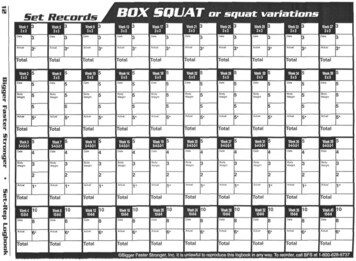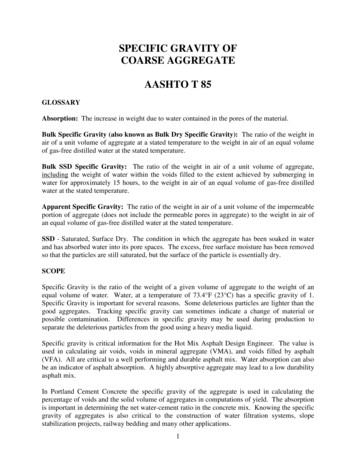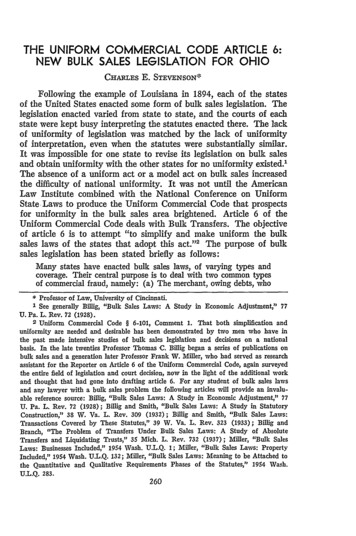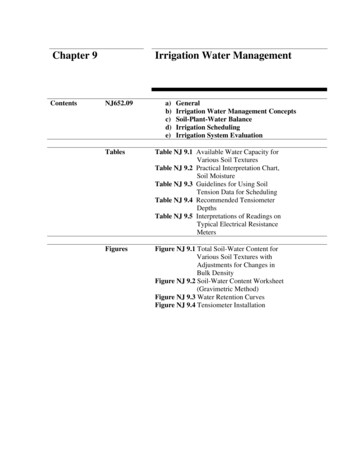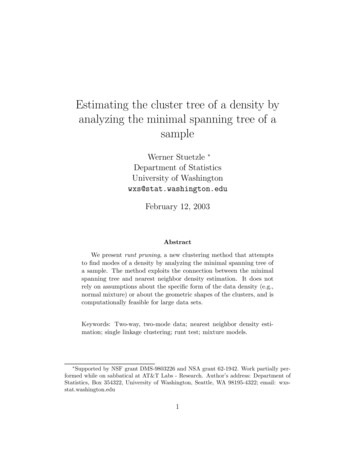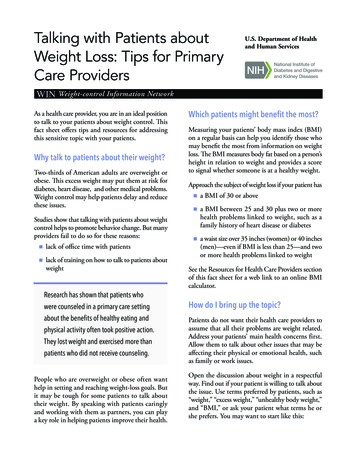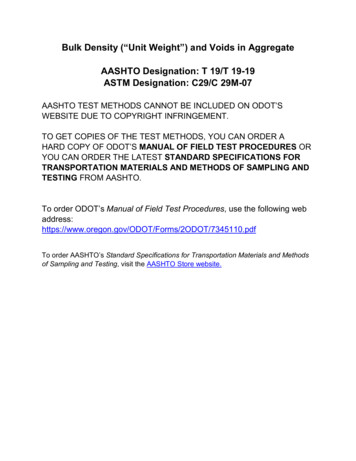
Transcription
Bulk Density (“Unit Weight”) and Voids in AggregateAASHTO Designation: T 19/T 19-19ASTM Designation: C29/C 29M-07AASHTO TEST METHODS CANNOT BE INCLUDED ON ODOT’SWEBSITE DUE TO COPYRIGHT INFRINGEMENT.TO GET COPIES OF THE TEST METHODS, YOU CAN ORDER AHARD COPY OF ODOT’S MANUAL OF FIELD TEST PROCEDURES ORYOU CAN ORDER THE LATEST STANDARD SPECIFICATIONS FORTRANSPORTATION MATERIALS AND METHODS OF SAMPLING ANDTESTING FROM AASHTO.To order ODOT’s Manual of Field Test Procedures, use the following /7345110.pdfTo order AASHTO’s Standard Specifications for Transportation Materials and Methodsof Sampling and Testing, visit the AASHTO Store website.
Compressive Strength of Cylindrical Concrete SpecimensAASHTO Designation: T 22-20ASTM Designation: C39/C 39M-05AASHTO TEST METHODS CANNOT BE INCLUDED ON ODOT’SWEBSITE DUE TO COPYRIGHT INFRINGEMENT.TO GET COPIES OF THE TEST METHODS, YOU MAY ORDER AHARD COPY OF ODOT’S MANUAL OF FIELD TEST PROCEDURES ORYOU MAY ORDER THE LATEST STANDARD SPECIFICATIONS FORTRANSPORTATION MATERIALS AND METHODS OF SAMPLING ANDTESTING FROM AASHTO.To order ODOT’s Manual of Field Test Procedures, use the following /7345110.pdfTo order AASHTO’s Standard Specifications for Transportation Materials and Methodsof Sampling and Testing, visit the AASHTO Store website.
Oregon Department of TransportationConstruction Section800 Airport Road SESalem, OR 97301-4798Telephone (503) 986-3000FAX (503) 986-3096DATE:October 31, 2007TO:All Holders of the Manual of Field Test ProceduresSECTION:Test Procedure AASHTO T 27/11File Code:The Oregon Department of Transportation has specified method(s) for this TestProcedure. Please observe the following for our projects: Under procedure Method A, step 1, the initial dry mass of the sample may bedetermined utilizing a companion moisture sample (this is an option not arequirement). Perform the moisture test according to T 255/ T 265. Shaking time for all methods will be a minimum of 10 minutes. Use the following formula to adjust the wet mass of the sample to the initialdry mass:Initial Dry Mass WM 1 % M 100 Where: WM Initial Wet Mass of T 27/11 sample.%M Moisture content of companion moisture sample. Document the Initial Wet Mass of the sample when utilizing a companionmoisture.
AGGREGATEWAQTCFOP AASHTO T 27 / T 11 (21)SIEVE ANALYSIS OF FINE AND COARSE AGGREGATESFOP FOR AASHTO T 27MATERIALS FINER THAN 75 µM (NO. 200) SIEVE IN MINERAL AGGREGATEBY WASHINGFOP FOR AASHTO T 11ScopeA sieve analysis, or ‘gradation,’ measures distribution of aggregate particle sizes within agiven sample.Accurate determination of the amount of material smaller than 75 µm (No. 200) cannot bemade using just AASHTO T 27. If quantifying this material is required, use AASHTO T 11in conjunction with AASHTO T 27.This FOP covers sieve analysis in accordance with AASHTO T 27-20 and materials finerthan 75 µm (No. 200) in accordance with AASHTO T 11-20 performed in conjunction withAASHTO T 27. The procedure includes three methods: A, B, and C.Apparatus Balance or scale: Capacity sufficient for the masses shown in Table 1, accurate to0.1 percent of the sample mass or readable to 0.1 g, and meeting the requirements ofAASHTO M 231 Sieves: Meeting the requirements of ASTM E11 Mechanical sieve shaker: Meeting the requirements of AASHTO T 27 Suitable drying equipment (refer to FOP for AASHTO T 255) Containers and utensils: A pan or vessel of sufficient size to contain the samplecovered with water and permit vigorous agitation without loss of material or water Optional-Mechanical washing device-Mallet: With a rubber or rawhide head having a mass of 0.57 0.23 kg(1.25 0.5 lb)Sample Sieving In all procedures, the sample is shaken in nested sieves. Sieves are selected to furnishinformation required by specification. Intermediate sieves are added for additionalinformation or to avoid overloading sieves, or both. The sieves are nested in order of increasing size from the bottom to the top, and thesample, or a portion of the sample, is placed on the top sieve. The loaded sieves are shaken in a mechanical shaker for approximately 10 minutes,refer to Annex A, Time Evaluation.T27 T11 short 21.docxAggregate 12-1Pub. October 2021
AGGREGATE WAQTCFOP AASHTO T 27 / T 11 (21)Care must be taken so that sieves are not overloaded, refer to Annex B, OverloadDetermination. The sample may be sieved in increments and the mass retained foreach sieve added together from each sample increment to avoid overloading sieves.Sample PreparationObtain samples according to the FOP for AASHTO R 90 and reduce to sample size, shownin Table 1, according to the FOP for AASHTO R 76.TABLE 1Sample Sizes for Aggregate Gradation TestNominal MaximumMinimum Dry MassSize* mm (in.)g (lb)125 (5)300,000 (660)100 (4)150,000 (330)90 (3 1/2)100,000 (220)75 (3)60,000 (130)63 (2 1/2)35,000 (77)50 (2)20,000 (44)37.5 (1 1/2)15,000 (33)25.0 (1)10,000 (22)19.0 (3/4)5000 (11)12.5 (1/2)2000 (4)9.5 (3/8)1000 (2)6.3 (1/4)1000 (2)4.75 (No. 4)500 (1)*Nominal maximum size: One sieve larger than the first sieve to retain more than 10 percent of thematerial using an agency specified set of sieves based on cumulative percent retained. Where largegaps between specification sieves exist, intermediate sieve(s) may be inserted to determine nominalmaximum size.Sample sizes in Table 1 are standard for aggregate sieve analysis, due to equipment restraintssamples may need to be divided into several “subsamples.” For example, a gradation thatrequires 100 kg (220 lbs.) of material would not fit into a large tray shaker all at once.Some agencies permit reduced sample sizes if it is proven that doing so is not detrimental tothe test results. Some agencies require larger sample sizes. Check agency guidelines forrequired or permitted sample sizes.T27 T11 short 21.docxAggregate 12-2Pub. October 2021
AGGREGATEWAQTCFOP AASHTO T 27 / T 11 (21)Selection of ProcedureAgencies may specify which method to perform. If a method is not specified, performMethod A.OverviewMethod A Determine original dry mass of the sample Wash over a 75µm (No. 200) sieve Determine dry mass of washed sample Sieve washed sample Calculate and report percent retained and passing each sieveMethod B Determine original dry mass of the sample Wash over a 75 µm (No. 200) sieve Determine dry mass of washed sample Sieve sample through coarse sieves, 4.75 mm (No. 4) sieves and larger Determine mass of fine material, minus 4.75 mm (No. 4) Reduce fine material Determine mass of reduced portion Sieve reduced portion Calculate and report percent retained and passing each sieveMethod C Determine original dry mass of the sample Sieve sample through coarse sieves, 4.75 mm (No. 4) sieves and larger Determine mass of fine material, minus 4.75 mm (No. 4) Reduce fine material Determine mass of reduced portion Wash reduced portion over a 75µm (No. 200) sieve Determine dry mass of washed reduced portion Sieve washed reduced portion Calculate and report percent retained and passing each sieveT27 T11 short 21.docxAggregate 12-3Pub. October 2021
AGGREGATEWAQTCFOP AASHTO T 27 / T 11 (21)Procedure Method A1. Dry the sample to constant mass according to the FOP for AASHTO T 255. Cool toroom temperature. Determine and record the original dry mass of the sample to thenearest 0.1 percent or 0.1 g. Designate this mass as M.When the specification does not require the amount of material finer than 75 µm(No. 200) be determined by washing, skip to Step 11.2. Nest a sieve, such as a 2.0 mm (No. 10), above the 75 µm (No. 200) sieve.3. Place the sample in a container and cover with water.Note 1: A detergent, dispersing agent, or other wetting solution may be added to the water to assure a thoroughseparation of the material finer than the 75 µm (No. 200) sieve from the coarser particles. There should beenough wetting agent to produce a small amount of suds when the sample is agitated. Excessive suds mayoverflow the sieves and carry material away with them.4. Agitate vigorously to ensure complete separation of the material finer than 75 µm(No. 200) from coarser particles and bring the fine material into suspension above thecoarser material. Avoid degradation of the sample when using a mechanical washingdevice.Note 2: Washing longer than 10 minutes in a mechanical washer has been shown to cause significant amountsof degradation depending upon aggregate type.5. Immediately pour the wash water containing the suspended material over the nestedsieves; be careful not to pour out the coarser particles or over fill the 75 µm (No. 200)sieve.6. Add water to cover material remaining in the container, agitate, and repeat Step 5.Continue until the wash water is reasonably clear.7. Remove the upper sieve and return material retained to the washed sample.8. Rinse the material retained on the 75 µm (No. 200) sieve until water passing through thesieve is reasonably clear and detergent or dispersing agent is removed, if used.9. Return all material retained on the 75 µm (No. 200) sieve to the container by rinsing intothe washed sample.Note 3: Excess water may be carefully removed with a bulb syringe; the removed water must be dischargedback over the 75 µm (No. 200) sieve to prevent loss of fines.10. Dry the washed sample to constant mass according to the FOP for AASHTO T 255.Cool to room temperature. Determine and record the dry mass of the sample.11. Select sieves required by the specification and those necessary to avoid overloading asdescribed in Annex B. With a pan on bottom, nest the sieves increasing in size startingwith the 75 µm(No. 200).12. Place the sample, or a portion of the sample, on the top sieve. Sieves may already be inthe mechanical shaker, if not place sieves in mechanical shaker and shake for theminimum time determined to provide complete separation for the sieve shaker being used(approximately 10 minutes, the time determined by Annex A).Note 4: Excessive shaking (more than 10 minutes) may result in degradation of the sample.T27 T11 short 21.docxAggregate 12-4Pub. October 2021
AGGREGATEWAQTCFOP AASHTO T 27 / T 11 (21)13. Determine and record the individual or cumulative mass retained for each sieve and in thepan. Ensure that all material trapped in full openings of the sieve are removed andincluded in the mass retained.Note 5: For sieves 4.75 mm (No. 4) and larger, check material trapped in less than a full opening by sievingover a full opening. Use coarse wire brushes to clean the 600 µm (No. 30) and larger sieves, and softbristle brushes for smaller sieves.Note 6: In the case of coarse / fine aggregate mixtures, distribute the minus 4.75 mm (No. 4) among two ormore sets of sieves to prevent overloading of individual sieves.14. Perform the Check Sum calculation – Verify the total mass after sieving agrees with thedry mass before sieving to within 0.3 percent. The dry mass before sieving is the drymass after wash or the original dry mass (M) if performing the sieve analysis withoutwashing. Do not use test results for acceptance if the Check Sum result is greater than0.3 percent.15. Calculate the total percentages passing, and the individual or cumulative percentagesretained to the nearest 0.1 percent by dividing the individual sieve masses or cumulativesieve masses by the original dry mass (M) of the sample.16. Report total percent passing to 1 percent except report the 75 µm (No. 200) sieve to0.1 percent.Method A CalculationsCheck Sum𝐶𝐶ℎ𝑒𝑒𝑒𝑒𝑒𝑒 𝑆𝑆𝑆𝑆𝑆𝑆 Percent Retained𝑑𝑑𝑑𝑑𝑑𝑑 𝑚𝑚𝑚𝑚𝑚𝑚𝑚𝑚 𝑏𝑏𝑏𝑏𝑏𝑏𝑏𝑏𝑏𝑏𝑏𝑏 ��𝑠 𝑡𝑡𝑡𝑡𝑡𝑡𝑡𝑡𝑡𝑡 𝑚𝑚𝑚𝑚𝑚𝑚𝑚𝑚 𝑎𝑎𝑎𝑎𝑎𝑎𝑎𝑎𝑎𝑎 ��𝑠 100𝑑𝑑𝑑𝑑𝑑𝑑 𝑚𝑚𝑚𝑚𝑚𝑚𝑚𝑚 𝑏𝑏𝑏𝑏𝑏𝑏𝑏𝑏𝑏𝑏𝑏𝑏 ��𝑠𝐼𝐼𝐼𝐼𝐼𝐼 Where:𝐼𝐼𝐼𝐼𝐼𝐼 100𝑀𝑀𝐶𝐶𝐶𝐶𝐶𝐶 𝐶𝐶𝐶𝐶𝐶𝐶 100𝑀𝑀IPR Individual Percent RetainedCPR Cumulative Percent RetainedM Original dry mass of the sampleIMR Individual Mass RetainedCMR T27 T11 short 21.docx𝑜𝑜𝑜𝑜Cumulative Mass RetainedAggregate 12-5Pub. October 2021
AGGREGATEWAQTCFOP AASHTO T 27 / T 11 (21)Percent Passing (PP)𝑃𝑃𝑃𝑃 𝑃𝑃𝑃𝑃𝑃𝑃 𝑃𝑃𝑃 100 𝐶𝐶𝐶𝐶𝐶𝐶PP Percent PassingPPP Previous Percent PassingMethod A Example Individual Mass RetainedOriginal dry mass of the sample (M):5168.7 gDry mass of the sample after washing:4911.3 gTotal mass after sieving equalsSum of Individual Masses Retained (IMR),including minus 75 µm (No. 200) in the pan:4905.9 gAmount of 75µm (No. 200) minus washed out (5168.7 g – 4911.3 g):257.4 gCheck Sum𝐶𝐶ℎ𝑒𝑒𝑒𝑒𝑒𝑒 𝑆𝑆𝑆𝑆𝑆𝑆 4911.3 𝑔𝑔 4905.9 𝑔𝑔 100 0.1%4911.3 𝑔𝑔The result is less than 0.3 percent therefore the results can be used for acceptance purposes.Individual Percent Retained (IPR) for 9.5 mm (3/8 in.) sieve:𝐼𝐼𝐼𝐼𝐼𝐼 619.2 𝑔𝑔 100 12.0%5168.7 𝑔𝑔Percent Passing (PP) 9.5 mm (3/8 in.) sieve:𝑃𝑃𝑃𝑃 86.0% 12.0% 74.0%Reported Percent Passing 74%T27 T11 short 21.docxAggregate 12-6Pub. October 2021
AGGREGATEWAQTCFOP AASHTO T 27 / T 11 (21)Method A IndividualGradation on All SievesSieve 2.5(1/2)724.79.5(3/8)619.24.75(No. 4)1189.82.36(No. 8)877.61.18(No. 16)574.80.600(No. 30)329.80.300(No. 50)228.50.150(No. 100)205.70.075(No. 200)135.4Determine IPRby dividing IMRby M andmultiplying by100IndividualPercentRetained(IPR)Determine PPby subtractingIPR fromprevious 0100.0 14.0 86.08686.0 12.0 74.07474.0 23.0 51.05151.0 17.0 34.03434.0 11.1 22.92322.9 6.4 16.51716.5 4.4 12.11212.1 4.0 8.188.1 2.6 5.55.50724.7 100 5168.714.01189.8 100 5168.723.0574.8 100 5168.711.1228.5 100 5168.74.4135.7 100 5168.72.6619.2 100 5168.712.0877.6 100 5168.717.0329.8 100 5168.76.4205.7 100 5168.74.0minus 0.075(No. 200)20.4in the panTotal mass after sieving sum of sieves mass in the pan 4905.9 gOriginal dry mass of the sample (M): 5168.7g* Report total percent passing to 1 percent except report the 75 µm (No. 200) sieve to0.1 percent.T27 T11 short 21.docxAggregate 12-7Pub. October 2021
AGGREGATEWAQTCFOP AASHTO T 27 / T 11 (21)Method A Example Cumulative Mass RetainedOriginal dry mass of the sample (M):5168.7 gDry mass of the sample after washing:4911.3 gTotal mass after sieving equals Final Cumulative Mass Retained(FCMR) (includes minus 75 µm (No. 200) from the pan):4905.9 gAmount of 75µm (No. 200) minus washed out (5168.7 g – 4911.3 g):257.4 gCheck Sum𝐶𝐶ℎ𝑒𝑒𝑒𝑒𝑒𝑒 𝑆𝑆𝑆𝑆𝑆𝑆 4911.3 𝑔𝑔 4905.9 𝑔𝑔 100 0.1%4911.3 𝑔𝑔The result is less than 0.3 percent therefore the results can be used for acceptance purposes.Cumulative Percent Retained (CPR) for 9.5 mm (3/8 in.) sieve:𝐶𝐶𝐶𝐶𝐶𝐶 1343.9 𝑔𝑔 100 26.0%5168.7 𝑔𝑔Percent Passing (PP) 9.5 mm (3/8 in.) sieve:𝑃𝑃𝑃𝑃 100.0% – 26.0% 74.0%Reported Percent Passing 74%T27 T11 short 21.docxAggregate 12-8Pub. October 2021
AGGREGATEWAQTCFOP AASHTO T 27 / T 11 (21)Method A CumulativeGradation on All SievesSieve 2.5(1/2)724.79.5(3/8)1343.94.75(No. 4)2533.72.36(No. 8)3411.31.18(No. 16)3986.10.600(No. 30)4315.90.300(No. 50)4544.40.150(No. 100)4750.10.075(No. 200)4885.5FCMR4905.9Determine CPRby dividing CMRby M andmultiplying by100CumulativePercentRetained(CPR)Determine PPby subtractingCPR from 0100100.0 14.0 86.086100.0 26.0 74.074100.0 49.0 51.051100.0 66.0 34.034100.0 77.1 22.923100.0 83.5 16.517100.0 87.9 12.112100.0 91.9 8.18100.0 94.5 5.55.50.0724.7 100 5168.71343.9 100 5168.714.026.02533.7 100 5168.749.03986.1 100 5168.777.14544.4 100 5168.787.94885.5 100 5168.794.53411.3 100 5168.766.04315.9 100 5168.783.54750.1 100 5168.791.9Total mass after sieving: 4905.9 gOriginal dry mass of the sample (M): 5168.7 g* Report total percent passing to 1 percent except report the 75 µm (No. 200) sieve to 0.1 percent.T27 T11 short 21.docxAggregate 12-9Pub. October 2021
AGGREGATEWAQTCFOP AASHTO T 27 / T 11 (21)Procedure Method B1. Dry the sample to constant mass according to the FOP for AASHTO T 255. Cool toroom temperature. Determine and record the original dry mass of the sample to thenearest 0.1 percent or 0.1 g. Designate this mass as M.When the specification does not require the amount of material finer than 75 µm(No. 200) be determined by washing, skip to Step 11.2. Nest a protective sieve, such as a 2.0 mm (No. 10), above the 75 µm (No. 200) sieve.3. Place the sample in a container and cover with water.Note 1: A detergent, dispersing agent, or other wetting solution may be added to the water to assure a thoroughseparation of the material finer than the 75 µm (No. 200) sieve from the coarser particles. There should beenough wetting agent to produce a small amount of suds when the sample is agitated. Excessive suds mayoverflow the sieves and carry material away with them.4. Agitate vigorously to ensure complete separation of the material finer than 75 µm(No. 200) from coarser particles and bring the fine material into suspension above thecoarser material. Avoid degradation of the sample when using a mechanical washingdevice.Note 2: Washing longer than 10 minutes in a mechanical washer has been shown to cause significant amountsof degradation depending upon aggregate type.5. Immediately pour the wash water containing the suspended material over the nestedsieves; be careful not to pour out the coarser particles or over fill the 75 µm (No. 200)sieve.6. Add water to cover material remaining in the container, agitate, and repeat Step 5.Continue until the wash water is reasonably clear.7. Remove the upper sieve and return material retained to the washed sample.8. Rinse the material retained on the 75 µm (No. 200) sieve until water passing through thesieve is reasonably clear and detergent or dispersing agent is removed, if used.9. Return all material retained on the 75 µm (No. 200) sieve to the container by rinsing intothe washed sample.Note 3: Excess water may be carefully removed with a bulb syringe; the removed water must be dischargedback over the 75 µm (No. 200) sieve to prevent loss of fines.10. Dry the washed sample to constant mass according to the FOP for AASHTO T 255.Cool to room temperature. Determine and record the dry mass after wash.11. Select sieves required by the specification and those necessary to avoid overloading asdescribed in Annex B. With a pan on bottom, nest the sieves increasing in size startingwith the 4.75 mm (No. 4).12. Place the sample, or a portion of the sample, on the top sieve. Sieves may already be inthe mechanical shaker, if not place the sieves in the mechanical shaker and shake for theminimum time determined to provide complete separation for the sieve shaker being used(approximately 10 minutes, the time determined by Annex A).Note 4: Excessive shaking (more than 10 minutes) may result in degradation of the sample.T27 T11 short 21.docxAggregate 12-10Pub. October 2021
AGGREGATEWAQTCFOP AASHTO T 27 / T 11 (21)13. Determine and record the individual or cumulative mass retained for each sieve. Ensurethat all particles trapped in full openings of the sieve are removed and included in themass retained.Note 5: For sieves 4.75 mm (No. 4) and larger, check material trapped in less than a full opening by sievingover a full opening. Use coarse wire brushes to clean the 600 µm (No. 30) and larger sieves, and soft hairbristle for smaller sieves.14. Determine and record the mass of the minus 4.75 mm (No. 4) material in the pan.Designate this mass as M1.15. Perform the Coarse Check Sum calculation – Verify the total mass after coarse sievingagrees with the dry mass before sieving to within 0.3 percent. The dry mass beforesieving is the dry mass after wash or the original dry mass (M) if performing the sieveanalysis without washing. Do not use test results for acceptance if the Check Sum resultis greater than 0.3 percent.16. Reduce the minus 4.75 mm (No. 4) according to the FOP for AASHTO R 76 to produce asample with a minimum mass of 500 g. Determine and record the mass of the minus4.75 mm (No. 4) split, designate this mass as M2.17. Select sieves required by the specification and those necessary to avoid overloading asdescribed in Annex B. With a pan on bottom, nest the sieves increasing in size startingwith the 75 µm (No. 200) up to, but not including, the 4.75 mm (No. 4) sieve.18. Place the sample portion on the top sieve and place the sieves in the mechanical shaker.Shake for the minimum time determined to provide complete separation for the sieveshaker being used (approximately 10 minutes, the time determined by Annex A).19. Determine and record the individual or cumulative mass retained for each sieve and in thepan. Ensure that all particles trapped in full openings of the sieve are removed andincluded in the mass retained. (See Note 5.)20. Perform the Fine Check Sum calculation – Verify the total mass after sieving agrees withthe dry mass before sieving (M2) to within 0.3 percent. Do not use test results foracceptance if the Check Sum result is greater than 0.3 percent.21. Calculate to the nearest 0.1 percent, the Individual Mass Retained (IMR) or CumulativeMass Retained (CMR) of the size increment of the reduced sample and the originalsample.22. Calculate the total percent passing.23. Report total percent passing to 1 percent except report the 75 µm (No. 200) sieve to0.1 percent.T27 T11 short 21.docxAggregate 12-11Pub. October 2021
AGGREGATEWAQTCFOP AASHTO T 27 / T 11 (21)Method B CalculationsCheck � 𝐶𝐶ℎ𝑒𝑒𝑒𝑒𝑒𝑒 𝑆𝑆𝑆𝑆𝑆𝑆 𝑑𝑑𝑟𝑟𝑦𝑦 𝑚𝑚𝑚𝑚𝑠𝑠𝑠𝑠 𝑏𝑏𝑏𝑏𝑏𝑏𝑏𝑏𝑏𝑏𝑏𝑏 ��𝑠𝑠𝑠 𝑡𝑡𝑡𝑡𝑡𝑡𝑡𝑡𝑡𝑡 𝑚𝑚𝑚𝑚𝑚𝑚𝑚𝑚 𝑎𝑎𝑎𝑎𝑎𝑎𝑎𝑎𝑎𝑎 𝑐𝑐𝑐𝑐𝑐𝑐𝑐𝑐𝑐𝑐𝑐𝑐 ��𝑠 100𝑑𝑑𝑑𝑑𝑑𝑑 𝑚𝑚𝑚𝑚𝑚𝑚𝑚𝑚 𝑏𝑏𝑏𝑏𝑏𝑏𝑏𝑏𝑏𝑏𝑏𝑏 ��𝑠𝐹𝐹𝐹𝐹𝐹𝐹𝐹𝐹 𝐶𝐶ℎ𝑒𝑒𝑒𝑒𝑒𝑒 𝑆𝑆𝑆𝑆𝑆𝑆 𝑀𝑀2 𝑡𝑡𝑡𝑡𝑡𝑡𝑡𝑡𝑡𝑡 𝑚𝑚𝑚𝑚𝑚𝑚𝑚𝑚 𝑎𝑎𝑎𝑎𝑎𝑎𝑎𝑎𝑎𝑎 𝑓𝑓𝑓𝑓𝑓𝑓𝑓𝑓 ��𝑠 100𝑀𝑀2Percent Retained for 4.75 mm (No. 4) and larger𝐼𝐼𝐼𝐼𝐼𝐼 Where:𝐼𝐼𝐼𝐼𝐼𝐼 � 𝐶𝐶𝐶𝐶𝐶𝐶 100𝑀𝑀IPR Individual Percent RetainedCPR Cumulative Percent RetainedM Original dry mass of the sampleIMR Individual Mass RetainedCMR Cumulative Mass RetainedPercent Passing (PP) for 4.75 mm (No. 4) and larger𝑃𝑃𝑃𝑃 𝑃𝑃𝑃𝑃𝑃𝑃 𝐼𝐼𝐼𝐼𝐼𝐼Where:T27 T11 short 21.docx𝑜𝑜𝑜𝑜𝑃𝑃𝑃𝑃 100 𝐶𝐶𝐶𝐶𝐶𝐶PP Percent PassingPPP Previous Percent PassingAggregate 12-12Pub. October 2021
AGGREGATEWAQTCFOP AASHTO T 27 / T 11 (21)Minus 4.75mm (No. 4) adjustment factor (R)The mass of material retained for each sieve is multiplied by the adjustment factor, the totalmass of the minus 4.75 mm (No. 4) from the pan, M1, divided by the mass of the reducedsplit of minus 4.75 mm (No. 4), M2. For consistency, this adjustment factor is carried tothree decimal places.𝑅𝑅 where:𝑀𝑀1𝑀𝑀2R minus 4.75 mm (No. 4) adjustment factorM1 total mass of minus 4.75 mm (No. 4) before reducingM2 mass of the reduced split of minus 4.75 mm (No. 4)Total Individual Mass Retained (TIMR):𝑇𝑇𝑇𝑇𝑇𝑇𝑇𝑇 𝑅𝑅 𝐵𝐵where:TIMR Total Individual Mass RetainedR minus 4.75 mm (No. 4) adjustment factorB individual mass of the size increment in the reduced portionsievedTotal Cumulative Mass Retained (TCMR)𝑇𝑇𝑇𝑇𝑇𝑇𝑇𝑇 (𝑅𝑅 𝐵𝐵) 𝐷𝐷where:TCMR Total Cumulative Mass RetainedR minus 4.75 mm (No. 4) adjustment factorB cumulative mass of the size increment in the reduced portion sievedD cumulative mass of plus 4.75mm (No. 4) portion of sampleT27 T11 short 21.docxAggregate 12-13Pub. October 2021
AGGREGATEWAQTCFOP AASHTO T 27 / T 11 (21)Method B Example Individual Mass RetainedDry mass of total sample, before washing:3214.0 gDry mass of sample after washing:3085.1 gTotal mass after sievingSum of Individual Masses Retained (IMR) plus theminus 4.75 mm (No. 4) from the pan:3085.0 gAmount of 75 µm (No. 200) minus washed out (3214.0 g – 3085.1 g):128.9 gCoarse Check � 𝐶𝐶ℎ𝑒𝑒𝑒𝑒𝑒𝑒 𝑆𝑆𝑢𝑢𝑢𝑢 3085.1 𝑔𝑔 3085.0 𝑔𝑔 100 0.0%3085.1 𝑔𝑔The result is less than 0.3 percent therefore the results can be used for acceptance purposes.Individual Percent Retained (IPR) for 9.5 mm (3/8 in.) sieve𝐼𝐼𝐼𝐼𝐼𝐼 481.4 𝑔𝑔 100 15.0%3214.0 𝑔𝑔Percent Passing (PP) for 9.5 mm (3/8 in.) sieve:𝑃𝑃𝑃𝑃 95.0% 15.0% 80.0%Reported Percent Passing 80%T27 T11 short 21.docxAggregate 12-14Pub. October 2021
AGGREGATEWAQTCFOP AASHTO T 27 / T 11 (21)Method B IndividualGradation on Coarse 16.0(5/8)012.5(1/2)161.19.50(3/8)481.44.75(No. 4)475.8Determine IPRby dividing IMRby M andmultiplying by100IndividualPercentRetained(IPR)Determine PPby subtractingIPR fromprevious PPPercentPassing(PP)0161.1 100 3214.0481.4 100 3214.0475.8 100 3214.05.015.014.8100100.0 5.0 95.080.0 14.8 65.295.0 15.0 80.0Minus 4.75(No. 4)1966.7 (M1)in the panTotal mass after sieving: sum of sieves mass in the pan 3085.0 gOriginal dry mass of the sample (M): 3214.0 gFine SampleThe minus 4.75 mm (No. 4) from the pan, M1 (1966.7 g), was reduced according to the FOPfor AASHTO R 76, to at least 500 g. In this case, the reduced mass was determined to be512.8 g. This is M2.The reduced mass was sieved.Total mass after sieving equalsSum of Individual Masses Retained (IMR) includingminus 75 µm (No. 200) in the panT27 T11 short 21.docxAggregate 12-15511.8 gPub. October 2021
AGGREGATEWAQTCFOP AASHTO T 27 / T 11 (21)Fine Check Sum𝐹𝐹𝐹𝐹𝐹𝐹𝐹𝐹 𝐶𝐶ℎ𝑒𝑒𝑒𝑒𝑒𝑒 𝑆𝑆𝑆𝑆𝑆𝑆 512.8 𝑔𝑔 511.8 𝑔𝑔 100 0.2%512.8 𝑔𝑔The result is less than 0.3 percent therefore the results can be used for acceptance purposes.Adjustment Factor (R) for Total Individual Mass Retained (TIMR) on minus 4.75 (No.4) sievesThe mass of material retained for each sieve is multiplied by the adjustment factor (R) carriedto three decimal places.𝑅𝑅 where:𝑀𝑀1 1,966.7 𝑔𝑔 3.835𝑀𝑀2512.8 𝑔𝑔R minus 4.75 mm (No. 4) adjustment factorM1 total mass of minus 4.75 mm (No. 4) from the panM2 mass of the reduced split of minus 4.75 mm (No. 4)Each “individual mass retained” on the fine sieves must be multiplied by R to obtain theTotal Individual Mass Retained (TIMR).Total Individual Mass Retained (TIMR) for 2.00 mm (No. 10) sieve𝑇𝑇𝑇𝑇𝑇𝑇𝑇𝑇 3.835 207.1 𝑔𝑔 794.2 𝑔𝑔Individual Percent Retained (IPR) for 2.00 mm (No. 10) sieve:𝐼𝐼𝐼𝐼𝐼𝐼 T27 T11 short 21.docx794.2 𝑔𝑔 100 24.7%3214.0 𝑔𝑔Aggregate 12-16Pub. October 2021
AGGREGATEWAQTCFOP AASHTO T 27 / T 11 (21)Percent Passing (PP) 2 mm (No. 10) sieve:𝑃𝑃𝑃𝑃 65.2% 24.7% 40.5%Reported Percent Passing 41%Method B IndividualGradation on Fine SievesSieve Sizemm(in.)IndividualMass Retainedg(IMR)Determine TIMRby multiplying2.00(No. 10)207.1794.20.425(No. 40)187.9207.1 3.835 0.210(No. 80)59.9229.70.075(No. 200)49.159.9 3.835 𝑀𝑀𝑀𝑀2IMR by R 1 TotalIndividualMass Retained(TIMR)187.9 3.835 720.649.1 3.835 188.3minus 0.075(No. 200)7.8in the panTotal mass after sieving: sum of fine sieves the mass in the pan 511.8 gT27 T11 short 21.docxAggregate 12-17Pub. October 2021
AGGREGATEWAQTCFOP AASHTO T 27 / T 11 (21)Method B IndividualFinal Gradation on All SievesSieve 5/8)012.5(1/2)161.19.50(3/8)481.44.75(No. 4)475.82.00(No. 10)794.20.425(No. 40)720.60.210(No. 80)229.70.075(No. 200)188.3Determine IPRby dividingTIMR by M andmultiplying by100IndividualPercentRetained(IPR)Determine PPby subtractingIPR fromprevious 00.0 5.0 95.09595.0 15.0 80.08080.0 14.8 65.26565.2 24.7 40.54140.5 22.4 18.11818.1 7.1 11.01111.0 5.9 5.15.10161.1 100 3214.05.0481.4 100 3214.015.0794.2 100 3214.024.7475.8 100 3214.0720.6 100 3214.0229.7 100 3214.0188.3 100 3214.014.822.47.15.9minus 0.075(No. 200)29.9in the panOriginal dry mass of the sample (M): 3214.0 g* Report total percent passing to 1 percent except report the 75 µm (No. 200) sieve to 0.1 percent.T27 T11 short 21.docxAggregate 12-18Pub. October 2021
AGGREGATEWAQTCFOP AASHTO T 27 / T 11 (21)Method B Example Cumulative Mass RetainedOriginal dry mass of the sample (M):3214.0 gDry mass of sample after washing:3085.1 gTotal mass after sieving equalsCumulative Mass Retained (CMR) on the 4.75 (No. 4)plus the minus 4.75 mm (No. 4) in the pan:3085.0 gAmount of 75 µm (No. 200) minus washed out (3214.0 g – 3085.1 g):128.9 gCoarse Check � 𝑪𝑪𝑪𝑪𝑪𝑪𝑪𝑪𝑪𝑪 𝑺𝑺𝑺𝑺𝑺𝑺 3085.1 𝑔𝑔 3085.0 𝑔𝑔 100 0.0%3085.1 𝑔𝑔The result is less than 0.3 percent therefore the results can be used for acceptance purposes.Cumulative Percent Retained (CPR) for 9.5 mm (3/8 in.) sieve𝐶𝐶𝐶𝐶𝐶𝐶 642.5 𝑔𝑔 100 20.0%3214.0 𝑔𝑔Percent Passing (PP) for 9.5 mm (3/8 in.) sieve𝑃𝑃𝑃𝑃 100.0% 20.0% 80.0%Reported Percent Passing 80%T27 T11 short 21.docxAggregate 12-19Pub. October 2021
AGGREGATEWAQTCFOP AASHTO T 27 / T 11 (21)Method B CumulativeGradation on Coarse 16.0(5/8)012.5(1/2)161.19.50(3/8)642.54.75(No. 4)1118.3 (D)Determine CPRby dividing CMRby M andmultiplying by100CumulativePercentRetained(CPR)Determine PPby subtractingCPR from 100.0PercentPassing(PP)0161.1 100 3214.0642.5 100 3214.01118.3 100 3214.05.020.034.8Minus 4.75(No. 4)1966.7 (M1)in the panCMR: 1118.3 1966.7 3085.0Original dry mass of the sample (M): 3214.0 g100100.0 5.0 95.0100.0 34.8 65.2100.0 20.0 80.0Fine SampleThe mass of minus 4.75 mm (No. 4) material in the pan, M1 (1966.7 g), was reducedaccording to the FOP for AASHTO R 76, to at least 500 g. In this case, the reduced masswas determined to be 512.8 g. This is M2.The reduced mass was sieved.Total mass after fine sieving equalsFinal Cumulative Mass Retained (FCMR) (includes minus75 µm (No. 200) from the pan):511.8 gFine Check Sum𝐹𝐹𝐹𝐹𝐹𝐹𝐹𝐹 𝐶𝐶ℎ𝑒𝑒𝑒𝑒𝑒𝑒 𝑆𝑆𝑆𝑆𝑆𝑆 512.8 𝑔𝑔 511.8 𝑔𝑔 100 0.2%512.8 𝑔𝑔The result is less than 0.3 percent therefore the results can be used for acceptance purposes.T27 T11 short 21.docxAggregate 12-20Pub. October 2021
AGGREGATEWAQTCFOP AASHTO T 27 / T 11 (21)The cumulative mass of material retained for each sieve is multiplied by the adjustmentfactor (R) carried to three decimal places to obtain the Adjusted Cumulative Mass Retained(ACMR) and added to the cumulative mass retained on the 4.75 mm (No. 4)
aashto test methods cannot be included on odot's . website due to copyright infringement. to get copies of the test methods, you may order a . hard copy of odot's manual of field test procedures or you may order the latest standard specifications for transportation materials and methods of sampling and testing from aashto.

